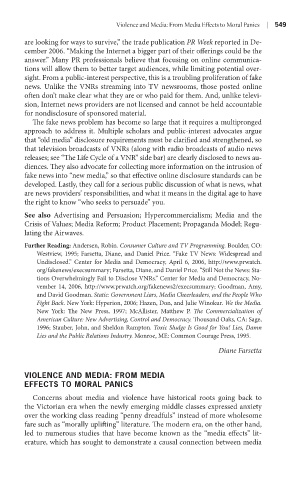Page 570 - Battleground The Media Volume 1 and 2
P. 570
V olence and Med a: From Med a Effects to Moral Pan cs |
are looking for ways to survive,” the trade publication PR Week reported in De-
cember 2006. “Making the Internet a bigger part of their offerings could be the
answer.” Many PR professionals believe that focusing on online communica-
tions will allow them to better target audiences, while limiting potential over-
sight. From a public-interest perspective, this is a troubling proliferation of fake
news. Unlike the VNRs streaming into TV newsrooms, those posted online
often don’t make clear what they are or who paid for them. And, unlike televi-
sion, Internet news providers are not licensed and cannot be held accountable
for nondisclosure of sponsored material.
The fake news problem has become so large that it requires a multipronged
approach to address it. Multiple scholars and public-interest advocates argue
that “old media” disclosure requirements must be clarified and strengthened, so
that television broadcasts of VNRs (along with radio broadcasts of audio news
releases; see “The Life Cycle of a VNR” side bar) are clearly disclosed to news au-
diences. They also advocate for collecting more information on the intrusion of
fake news into “new media,” so that effective online disclosure standards can be
developed. Lastly, they call for a serious public discussion of what is news, what
are news providers’ responsibilities, and what it means in the digital age to have
the right to know “who seeks to persuade” you.
see also Advertising and Persuasion; Hypercommercialism; Media and the
Crisis of Values; Media Reform; Product Placement; Propaganda Model; Regu-
lating the Airwaves.
Further reading: Andersen, Robin. Consumer Culture and TV Programming. Boulder, CO:
Westview, 1995; Farsetta, Diane, and Daniel Price. “Fake TV News: Widespread and
Undisclosed.” Center for Media and Democracy, April 6, 2006, http://www.prwatch.
org/fakenews/execsummary; Farsetta, Diane, and Daniel Price. “Still Not the News: Sta-
tions Overwhelmingly Fail to Disclose VNRs.” Center for Media and Democracy, No-
vember 14, 2006, http://www.prwatch.org/fakenews2/execsummary; Goodman, Amy,
and David Goodman. Static: Government Liars, Media Cheerleaders, and the People Who
Fight Back. New York: Hyperion, 2006; Hazen, Don, and Julie Winokur. We the Media.
New York: The New Press, 1997; McAllister, Matthew P. The Commercialization of
American Culture: New Advertising, Control and Democracy. Thousand Oaks, CA: Sage,
1996; Stauber, John, and Sheldon Rampton. Toxic Sludge Is Good for You! Lies, Damn
Lies and the Public Relations Industry. Monroe, ME: Common Courage Press, 1995.
Diane Farsetta
ViolenCe and Media: FroM Media
eFFeCts to Moral PaniCs
Concerns about media and violence have historical roots going back to
the Victorian era when the newly emerging middle classes expressed anxiety
over the working class reading “penny dreadfuls” instead of more wholesome
fare such as “morally uplifting” literature. The modern era, on the other hand,
led to numerous studies that have become known as the “media effects” lit-
erature, which has sought to demonstrate a causal connection between media

